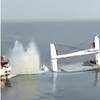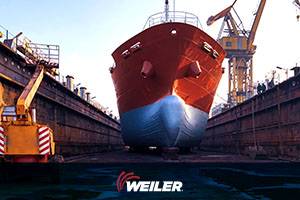In the USCG Authorization Act of 1996, the USCG was directed to assess the risk of spills for oils that may sink or be negatively buoyant, to examine and evaluate existing cleanup technologies, and to identify and appraise technological and financial barriers that could impede a prompt response to such spills. The USCG requested the National Research Council (NRC) perform these tasks. In response to this request, the NRC established the Committee on the Marine Transportation of Heavy Oils.
Maritime accidents resulting in oil spills are high on the list of public environmental concerns. These spills are difficult to control and can contaminate the marine environment. When oil is spilled on the sea, it undergoes physical, chemical, and biological changes as it weathers and is degraded by bacteria. Most oil spill cleanup technologies, which have been developed for floating oils and the ensuing emulsions, are not very effective. For most spills, only about 10 to 15 percent of the oil is recovered, and the best recovery rates are probably about 30 percent.
Oils with a specific gravity of >1.0, referred to as Group V oils, include some heavy fuel oils, asphalt products, and very heavy crude oils. Vessels and terminals that handle Group V oils are required to include responses to spills of Group V oils in their facility response plans.
Oils that sink to the bottom or remain suspended in the water column pose risks to certain resources that are not normally affected by floating oils. These resources include fish, shellfish, seagrasses, and other benthic (seabed) and water-column biota. Submerged oil may also cause episodic re-oiling of shorelines.
The objectives of the study were:
· To assess threats posed by the marine transportation of Group V oils by characterizing the trade of such oils and, in general terms, the resources at risk;
· To assess the adequacy of cleanup technologies for spills of Group V oils and recommend research to develop new technologies and techniques, as appropriate; and
· To identify barriers to effective responses to spills and recommend technological, financial, or management measures that would promote prompt and effective responses to spills of Group V oils.
Early in the committee's deliberations, it became clear that the statutory definition of Group V oils did not include all the oils of concern. The first problem with using this definition is specific gravity is defined as the ratio of the density of oil to the density of freshwater at a fixed temperature. The density of seawater, however, is slightly higher than that of freshwater and increases as salt content increases. Therefore, Group V oils could have lower densities than those of the receiving seawater and float.
The committee, therefore, decided to use the term "nonfloating oils" to include all of the oils of concern based on their behavior. Nonfloating oils move below the sea surface either because of their initial densities or because of changes in their densities as a result of weathering or interaction with sediments. These oils may be just below the water surface, suspended in the water column, or deposited on the seabed.
Nonfloating oils behave differently and have different environmental fates and effects than floating oils. The resources at greatest risk from spills of floating oils are those that use the water surface and the shoreline. Floating-oil spills seldom have significant impacts on water-column and benthic resources, whereas nonflowing oils pose a substantial threat.
Since 1991, the volume of oil spilled from vessels in U.S. waters has been reduced dramatically. Losses from tankers since 1990 have been less than one-tenth of the pre-1990 volume, and losses from barges have been less than one-third of the pre-1990 volume. From 1973 to 1990, there were 18 incidents involving spills of more than 25,000 barrels. Since 1991, there has not been a single spill of this magnitude for any category of oil. Nevertheless, very large spills will almost certainly occur some time in the future, although they are likely to be spills of crude oil rather than heavy oils, which tend to be transported in smaller volumes on barges and smaller tankers.
The committee identified a variety of barriers to responses to spills of nonfloating oils, including inadequate planning and training drills; lack of experience; lack of knowledge about transport, fate, and impact on the environment; the difficulty of locating and tracking oil suspended in the water column or deposited on the seabed; the limited technology options available for containment and recovery; and insufficient investment in research, development, testing, and evaluation of tracking, containment, and recovery systems.
Findings
From 1991 to 1996, approximately 17 percent of the petroleum products transported over U.S. waters were heavy oils and heavy-oil products, such as residual fuel oils, coke, and asphalt. Approximately 44 percent was moved by barge and 56 percent by tanker.
In the same time period, approximately 23 percent of the petroleum products spilled in U.S. waters were heavy oils. In only 20 percent of these spills did a significant portion of the spilled products sink or become suspended in the water column. Most of the time, spills of heavy oil remained on the surface. The committee projects a 30 percent reduction in the number and volume of heavy-oil spills would have been realized if tankers and barges had all been double-hulled vessels.
The committee found inland barges are subject to greater risks of spills than tankers and coastal barges; consequently, spill rates for barges are likely to be higher than for tankers. However, the large difference between the overall spill rates, as well as the decreasing number of spills from tankers in recent years (post-OPA 90), raises concerns regarding the performance of barges.
From 1991 to 1996, barges accounted for approximately 80 percent of the volume of heavy-oil spills, and the spill rate, expressed in terms of barrels-spilled-per-ton-mile, was more than 10 times higher for barges than for tankers. Although the reduction in spill volume from tank barges since 1990 has been significant (about one-third of pre-1990 volume), the reduction for tankers has been even more dramatic (about one-tenth of pre-1990 volume).
Today's Technology
A substantial number of techniques and tools for tracking subsurface oil have been developed. Most of them, however, have not been used in response to actual oil spills. Many techniques are available for determining the location of oil both in the water column and on the seabed. These include visual observations, geophysical and acoustic methods, remote sensing, water-column and seabed sampling, in situ detectors, and nets and trawl sampling.
The most direct and simplest methods, such as diver observations and direct sampling, are widely used, but they are labor intensive and slow.
More sophisticated approaches, such as remote sensing, are limited to zones very near the sea surface because of technical constraints. Other advanced technologies, such as acoustic techniques, cannot differentiate between oil and water or between oiled sediments and underlying sediments.
Many of the more sophisticated systems are prone to misuse and produce ambiguous data that are subject to misinterpretation. The performance of all but the simplest methods is undocumented either by field experiments or by use in spill responses.
Although many technologies are available for containing and recovering subsurface oil, few are effective, and most work only in very limited environmental conditions. Containment of oil suspended in the water column using silt curtains, pneumatic barriers, and nets and trawls is only effective in areas with very low currents and minimal wave activity. These conditions rarely exist at spill sites, particularly at sites in estuarine or coastal waters.
Additionally, the committee found the lack of knowledge, experience and planning for spills of nonfloating oils is inadequate, particularly at the local level. Even at the national level, no system has been developed for sharing experiences or documenting the effectiveness and limitations of various options. With limited experience and a lack of proven, specialized systems, responders have found it difficult to adapt available equipment for responses to spills of nonfloating oils.
Recommendations
The Committee on the Marine Transportation of Heavy Oils made the following recommendations:
· The USCG should direct area planning committees to assess the risk of spills of nonfloating oils to determine the resources at risk. In areas with significant environmental resources risk, area planning committees should develop response plans that include consultation and coordination protocols and should obtain pre-approvals and authorizations to facilitate responses to spills. Stakeholder groups should be educated about the impact and methods available for tracking, containing, and recovering oil suspended in the water column or on the seabed. Area committees in locations where there is a high risk of spills of nonfloating oils should include at least one scenario for responding to a nonfloating-oil spill in their training or drill programs.
· The USCG should improve its knowledge base, education, and training for responding to spills of nonfloating oils by including a scenario involving a spill of nonfloating oils in oil-spill response drills, by establishing a knowledge base and scientific support teams to respond to these types of spills, and by disseminating this knowledge to the federal spill-response coordinators and area planning committees as part of ongoing training programs. The information would help area planners assess the requirements for responding to nonfloating-oil spills.
· The USCG should support the development and implementation of an evaluation program for tracking oil in the water column and on the seabed, as well as containment and recovery techniques for use on the seabed. The findings of these evaluations should be documented and distributed to the environmental response community to improve response plans for spills of nonfloating oils.
· Tests of area contingency plans and industry response plans for responses to spills of nonfloating oils should be required parts of training and drill programs.
· The USCG should monitor spill rates from tank barges to ascertain whether current regulatory requirements and voluntary programs will reduce the frequency and volume of spill incidents. If not, the USCG should consider initiating regulatory changes.
Courtesy of the National Academy of Sciences, Washington, D.C.
Sponsored Content
Safer Starts Here: Build Ships, Protect Crews

Subscribe for
Maritime Reporter E-News
Maritime Reporter E-News is the maritime industry's largest circulation and most authoritative ENews Service, delivered to your Email five times per week











